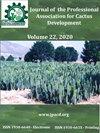Boundary-Line Approach micro-nutrient optimum concentrations and sufficiency ranges for Opuntia ficus-indica (L.) Miller fruiting
IF 0.4
4区 农林科学
Q4 HORTICULTURE
Journal of the Professional Association for Cactus Development
Pub Date : 2021-11-19
DOI:10.56890/jpacd.v23i.472
引用次数: 0
Abstract
Optimum concentrations and/or sufficiency ranges of nutrients are useful for correct diagnosis and improvements of nutrient status of cultivated plants. However, Opuntia ficus-indica nutrient storage at plant and cladode levels and best fit plant requirements for fruiting remain practically unknown. Then, this research work aimed to identify the Boundary-Line Approach (B-LA) micronutrient optimum concentrations linked to maximum fruit yield per one-year old fructification cladode and sufficiency ranges at 90% maximum fruit yield for O. ficus-indica variety ‘Rojo Pelón’. Four years (2012 – 2015) data of fruit yield per cladode and micronutrient concentrations (B, Cu, Fe, Mn, and Zn) were used for the elaboration of scatter diagrams (n = 228) and selection of 7 to 10 points to estimate the B-LA quadratic functions. Then, the vertices allowed estimation of the optimum micronutrient concentrations: B = 33.62 mg kg–1, Cu =11.74 mg kg–1, Fe = 108.51 mg kg–1, Mn = 149.33 mg kg–1 and Zn = 414.91 mg kg–1 as linked to estimated maximum yield per cladode; and the sufficiency ranges at 90% maximum fruit yield: B = 24.44 to 46.25 mg kg–1, Cu = 8.68 – 15.87 mg kg–1, Fe = 73.73 – 143.3 mg kg–1, Mn = 114.89 – 183.77 mg kg–1 and Zn = 334.31 – 514.95 mg kg–1. The linked estimated maximum fruit yield per cladode varies from 1999.48 g to 2139.59 g. The proposed B-LA standards can be used to perform reliable micronutrient diagnosis and proper fertilization recommendations.边界线法研究仙人掌密勒结果微营养物质的最佳浓度和适宜范围
营养物质的最佳浓度和/或充足范围有助于正确诊断和改善栽培植物的营养状况。然而,榕树在植株和枝级水平上的营养储存以及最适合植物结实需要的情况实际上仍然未知。然后,本研究旨在确定红线方法(B-LA)微量营养素的最佳浓度与每一年生果枝的最大果实产量和最大果实产量90%的充足范围。采用4年(2012 - 2015)单枝果实产量和微量元素(B、Cu、Fe、Mn和Zn)浓度数据绘制散点图(n = 228),选取7 ~ 10个点估算B- la二次函数。然后,利用这些顶点可以估计出最佳微量营养素浓度:B = 33.62 mg kg-1, Cu =11.74 mg kg-1, Fe = 108.51 mg kg-1, Mn = 149.33 mg kg-1和Zn = 414.91 mg kg-1与估算的每枝枝最大产量有关;在90%最高产量时,B = 24.44 ~ 46.25 mg kg-1, Cu = 8.68 ~ 15.87 mg kg-1, Fe = 73.73 ~ 143.3 mg kg-1, Mn = 114.89 ~ 183.77 mg kg-1, Zn = 334.31 ~ 514.95 mg kg-1。每枝的相关估计最大果实产量从1999.48克到2139.59克不等。所提出的B-LA标准可用于进行可靠的微量营养素诊断和适当的施肥建议。
本文章由计算机程序翻译,如有差异,请以英文原文为准。
求助全文
约1分钟内获得全文
求助全文
来源期刊

Journal of the Professional Association for Cactus Development
Agricultural and Biological Sciences-Plant Science
CiteScore
1.10
自引率
33.30%
发文量
10
期刊介绍:
The editors of the Journal of the Professional Association for Cactus Development, are very excited to be a part of the excellent editorial committee and to work together to create the synergism between scientists, growers, legislators, and business people so vital to the development of this industry to serve the people of arid lands.
 求助内容:
求助内容: 应助结果提醒方式:
应助结果提醒方式:


